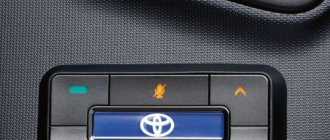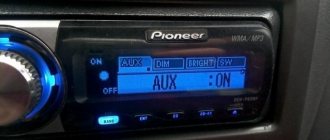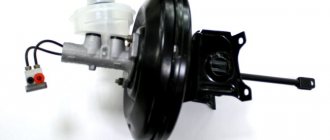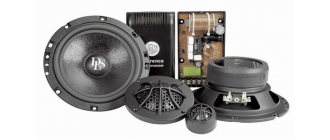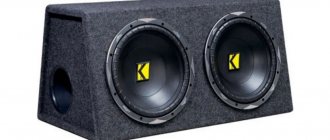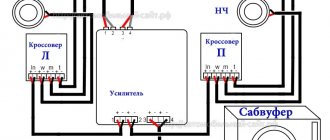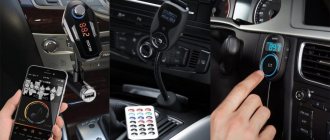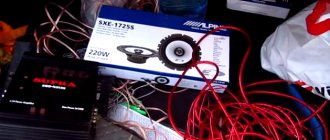Search
Often, when designing a speaker system, not all technical characteristics of the car radio are taken into account.
After all, users often simply have no idea whether they will install additional components. And at a certain stage it turns out that the car radio is simply not equipped with linear outputs. What to do? In order to obtain the required linear signal, you can use the following methods:
· Unsolder the linear output directly on the radio.
· Use the appropriate attachments to achieve the required signal.
· Soldering using an additional preamplifier. Thus, it will be possible to significantly increase the signal level.
· Use of an amplifier that has a high-level input.
Based on the available options, they can be divided into groups. In the first case, no additional actions are performed in relation to the radio; in the second, direct intervention is required. But do not forget that as soon as the integrity of the head equipment is damaged, you will not be able to use the warranty. Therefore, we choose the first option.
TechnoCarAudio. For all occasions. Six ways to connect an amplifier. Part III
- Published 07/24/2014 17:18 Number We continue our acquaintance with the secrets of selecting and installing audio system components. Previously (TA No. 01, 02/2011) we figured out the types of power amplifiers and decided on what adjustments they should have. Now is the time to look at how they can be connected in general. It turns out that there are many nuances here too. METHOD ONE. SIMPLE At first glance, there is nothing complicated in connecting a car amplifier - we take an interconnect cable and connect it to the linear outputs of the head unit with the linear inputs of the amplifier. Both of them are made in the form of RCA connectors (or, in common parlance, “tulips”). Everything seems simple. But let's assume that you are going to connect a 4-channel amplifier to your head unit. It has two pairs of linear inputs, and in general, to connect, you will need to send signals from the head unit to both of these pairs. And so you take your radio, and it has... not two, but only one pair of outputs. What to do? The most common way to connect amplifiers is using line inputs. A PAIR OF MORE WAYS. FOUR TO TWO When choosing the right 4-channel amplifier for this situation, the first thing you should pay attention to is the presence of a small switch called an input selector. It allows you to switch the amplifier's linear inputs from the normal mode (when each pair of channels operates from its own pair of inputs) to a mode in which both pairs of channels will operate from only one pair of inputs. If there is such a switch, then that’s it, the problem is solved. If the head unit does not have enough linear outputs, then you can choose an amplifier that has an input selector. But what to do if you just really like the amplifier, but it doesn’t have an input selector? In this case, you can resort to another solution, which is technically not so beautiful, but has a right to exist and works properly - a Y-splitter, a small cord with one input and two outputs. With its help, you can send a signal from the head unit to two inputs at once. Well, since we always deal with pairs of channels, to connect a 4-channel from one pair of linear outputs you will need, accordingly, two such splitters. If the amplifier is not equipped with an input selector, you can use simple Y-splitters. METHODS FOUR AND FIFTH. WHAT IS HIGH LEVEL INPUT? All these options are valid for cases where the head unit has at least one pair of linear outputs. But what if there are none at all? For example, they are almost never found in standard “heads”. You can, of course, resort to the help of specialists who, using a soldering iron, will equip the standard PG with linear outputs, to which you can connect the amplifier using any of the methods described above. Or you can go the other way - choose an amplifier that has High Level Inputs. In this case, the amplifier is connected directly to the “speaker” outputs of the head unit. Roughly speaking, we cut off the wires going to the standard speakers and connect them to these same amplifier inputs. And here, at first, doubt may creep in about the need for such an upgrade at all. Indeed, the standard system does not particularly shine with audiophile sound, so in addition to it we simply add another amplifier. Meaning? But, as practice shows, there is a meaning. One of the bottlenecks of the standard system, which spoils the sound the most, is the dead, low-power amplifier built into the head unit. In a standard system, it works on speakers, which always have a low impedance, usually from 2 to 8 ohms. Consequently, relatively decent currents flow in the output stages of the amplifier; we have already discussed the principle of operation in the first article of the “series”. If we disconnect the speakers from it and connect our new amplifier instead, the high level inputs of which have a resistance of tens or even hundreds of Ohms, then the output stages of the standard amplifier will work somewhat differently - much lower currents will flow through them. Such a change in their operating mode will have a beneficial effect on the quality of the signal transmitted by them. Roughly speaking, if you connect not speakers, but another amplifier, to the output of a standard amplifier, then, oddly enough, it will produce a higher quality signal. To connect the amplifier to a head unit without linear outputs, you can use high-level inputs; many amplifiers have them. . But let's say you already have an amplifier that you want to complement your standard system with, but it doesn't have high-level inputs. Can it be connected to speaker outputs? It turns out that this is not a big problem either, you just have to buy a high-level signal to linear converter, it is very inexpensive. If the amplifier does not have high-level inputs, then you can use signal converters that convert the signal from the speaker outputs of the head unit to linear. Such converters are not necessarily primitive devices; there are also more advanced models that provide additional signal processing capabilities, for example, filters, bass boosts and other useful things.
However, the lack of linear outputs is not the biggest problem that you have to face when upgrading standard systems. The real problem is when standard PGs lack not only linear outputs, but even a Remote output, which would serve as a command to turn on the amplifier. In this case, one of the simplest and most convenient solutions would be to choose an amplifier that has a switching function based on the presence of a signal at the high-level inputs.An amplifier with this function itself determines when a signal begins to arrive at it and automatically turns on. And as soon as you turn off the standard GU, the signal disappears, and accordingly, the amplifier also turns off. Many amplifiers equipped with high level inputs are equipped with such signal detection circuits; pay special attention to this when selecting a suitable model. METHOD SIX. WHEN THERE ARE SEVERAL AMPLIFIERS. Well, now we have figured out in general terms how one amplifier can be connected to the head unit. What if we want more? There are also possible options here. Pay attention to this detail - some amplifiers contain not only linear inputs, but also linear outputs. What are they needed for? Let us explain with a specific example. Let's say you have a head unit, but it only has one pair of line outputs, and you connect an amplifier to them, for example, for a subwoofer. Everything is just great, but suppose that one day you are tired of the modest sound of your main acoustics, and you decide to buy another amplifier, this time for it. How to connect a second amplifier? You can, of course, use one of the methods described above, but if your subwoofer amplifier has line outputs, then it is more logical and easier to connect your new amplifier to them.
Source: Car Tuning magazine (with the participation of Car&Music), March 2011. Text and drawings by Anton Nikolaev. Photos from various sources
magnetola.net
De-soldering of linear output from the radio
In order to succeed in this case, you need to have a certain attentiveness, as well as hands. Be sure to select a microcircuit. You can understand what her appearance is from the image. By the way, it is connected directly to a large radiator.
Once the diagram is found, you need to install the markings. After this, you need to find a datasheet in order to determine the acceptable wiring of the pins available on the circuit. It is from this input that the incoming signal is removed.
Undoubtedly, an attachment can also be used, with the help of which the signal level will be reduced. Nowadays, such equipment is actively going on sale. And they don’t have any special design features. And if there is a need, you can prepare it yourself using the following diagrams:
Connecting a subwoofer to a radio without a subwoofer output
- 18.09.2009 00:06 #1
Hello forum members. My radio does not have a sub output - only 4 linear channels. Tell me how to connect an amplifier so that it can pump 4 speakers and a sub. Any kind of amplification won’t work here - maybe there are some special ones that you can use to get 4 channels and at the output it will give 4 +1? Also, probably the power should be with remote (driver's) subwoofer level adjustment, because... For obvious reasons, this case is not in the radio tape recorder. Please tell me. How is this problem solved and can you point me to a specific model? Thanks in advance...Useful topics:
- 18.09.2009 00:06 # 0+
- Please note the list of useful topics in the first message.
- There is no need to register to explore the Forum - almost all relevant content, including files, pictures and videos, is open to guests.
Terms and the most popular models in messages are highlighted with quick tips and links to relevant articles in MagWikipedia and the Catalog.
Best wishes, Administration of the Car Audio Forum Radio
It will be enough to just buy a tulip splitter, or so that it has an output channel (there are a decent number of these), the main disadvantage of this is the lack of adjustment of the subwoofer level from the head.
If the budget allows, then this is a sweetie https://www.magnitola.ru/DLS-RA50-p-4921.html If there is a lack of bass SAR, a mode switch on the mustache is used which will send a signal to channel 5 from other channels. Has a remote bass control
Message from BiS Hello forum members. My radio does not have a sub output - only 4 linear channels. Tell me how to connect an amplifier so that it can pump 4 speakers and a sub. Any kind of amplification won’t work here - maybe there are some special ones that you can use to get 4 channels and at the output it will give 4 +1? Also, probably the power should be with remote (driver's) subwoofer level adjustment, because... For obvious reasons, this case is not in the radio tape recorder. Please tell me. How is this problem solved and can you point me to a specific model?
Thanks in advance…
There are several options. 1. Connect sub channels to the rear lines and to the front speakers. Speakers front + rear or mid + tweeter? If the mid and tweeter are connected through standard crossovers. 2. Use Y-shaped splitters, although in this case you will have to forget about adjustments from the radio. 3. In a circuit with two amplifiers, connect the second amplifier to the linear outputs of the first amplifier.
Posted by karek
or so that it has an output channel (there are a decent number of these), the main disadvantage of this is the lack of adjustment of the subwoofer level from the head.
What is an “amplifier with an output channel” - can you explain it in your fingers?
regarding the lack of adjustment from the head - this is of course inconvenient, but I saw the amp with a subwoofer level knob - I think this will save private Ryan
———- Post added at 23:25 ———- Previous post was at 23:18 ———-
Message from Camel If the budget allows, then this is candy https://www.magnitola.ru/DLS-RA50-p-4921.html If there is a lack of bass SAR, a mode switch on the mustache is used which will send a signal to channel 5 from other channels. It has an external bass regulator 1. As I understand it, I plug 4 channels into this amp and it will output the 5th channel to the sub? Do all 5 channels have this feature? 2. The price is acceptable and the power, judging by the characteristics, is not bad - what’s bad? https://www.magnitola.ru/Helix-Xmax-5-1-p-7055.html
Message from BiS What is an “amplifier with an output channel” - can you explain it in your fingers?
regarding the lack of adjustment from the head - this is of course inconvenient, but I saw the amp with a subwoofer level knob - I think this will save private Ryan
Amplifier with output channel - an amplifier that has line outputs, for example Helix DB FOUR
Posted by The Elk
1. Connect sub channels to the rear lines and to the front speakers. .
So if you connect a sub to the rear ones, then only the front ones will boost the power, and who will boost the rear ones?
Message from BiS So if you connect a sub to the rear ones, then only the front ones will boost the power, and who will boost the rear ones? Are rear speakers necessary at all?
Message from The Elk An amplifier with an output channel is an amplifier that has linear outputs, for example Helix DB FOUR, does it mean that a second amplifier for the sub is connected to the linear output of the amplifier? No, I want to get by with one effort.
———- Post added at 23:37 ———- Previous post was at 23:35 ———-
Posted by The Elk Are rear speakers even necessary? for MP3 music - no, for DVD movies or multi-channel music - of course they are needed.
Message from BiS
What do you mean by connecting the second amplifier to the linear output of the amplifier? No, I want to get by with one effort.
Then remove the rear speakers, leave the front + sub from the four-channel and don’t try to shove in something that’s not my thing.
magnetola.org
Making AUX on a car radio
In this case, setting up the subwoofer will be done from the trunk, which is not always convenient.
Remember to place the active subwoofer in the trunk. This is largely due to the size of such acoustics. You will need to run a wire from the radio into the trunk, which is necessary to control the operating parameters of the subwoofer. You will also need a power plus and minus. To perform power plus and minus, you need to use a multi-core cable. The presence of such a power cable will allow you to connect a subwoofer in a car without using line outputs. In this case, the cable cross-section must exceed 6 square millimeters. You can buy such a cable at any automotive market.
We find any bolt screwed to it on the car body. We clean the bolt from paint, which will ensure the highest quality metal contact. We wrap one turn of the power cable around the bolt and tighten the bolt tightly. This way you can make the minus power wire necessary to connect the subwoofer in the car.
The power plus is a little more difficult to perform. We take a wire with a cross-section of at least 6 millimeters square and lay it in the trunk through the interior of the car. You will need to find or independently make a small diameter hole in the partition between the passenger compartment and the engine compartment. You can drill such a hole using a drill with a metal drill bit.
When passing the wire through such a hole, use an insulating rubber sleeve. This sleeve will protect the cable from chafing and save you from short circuits. We connect the cable to the positive terminal on the battery. We recommend using plastic clamps to secure the cable along the length of the contact. Do not forget also about the need to use a fuse that cuts into the power cable directly near the positive terminal of the battery.
To connect a subwoofer to a radio if it does not have linear outputs, you need to use high-amplitude inputs designed for the built-in amplifier. From the radio we extend the control cable into the trunk to the subwoofer. We connect high-amplitude outputs on the radio to the speaker system. Remember to maintain polarity. We connect the control and signal wires to the connection point of the amplifier block.
READ How to connect a tachometer to Volga 31029
Switching must be carried out in full accordance with the connection diagram. Only after this you can start adjusting the sound. Having completed the setup, we install the radio in place and carefully secure the subwoofer.
At this point, the work of connecting the subwoofer to the radio without its linear outputs is completely completed. You can enjoy high-quality sound, and by carrying out all the necessary installation work yourself, you will save on using the services of professional specialists.
Source
How to connect a car amplifier if the car radio does not have linear outputs
- Car radios: Prology NTE-450NR, Prology LXR-450RN, Prology NTE-450N, Prology LVE-450RN, Prology LXR-450N, Prology LXR-430R, Prology LXR-430, Prology LXR-400R, Prology NTE-430R, Prology LVE- 400R, Prology LXR-400, Prology NTE-430, Prology LVE-450N, Prology LVE-430R, Prology NTE-400R, Prology NTE-400, Prology LVE-430, Prology LVE-400
2019-05-31 - Acoustics: Infinity Alpha 650C, Infinity Alpha 6530, Infinity Alpha 6520, Infinity Alpha4020
2019-05-30 - Acoustics: Alphard Hannibal MH-60, Alphard Hannibal MH-50
- Amplifier: Alphard Doomsday ARU 3000/2
2019-05-07 - Head units: Pioneer AVH-Z9200BT, Pioneer AVH-Z2200BT, Pioneer AVH-Z5200BT
2019-04-26 - Subwoofer: Kicx GT-12M
- Speakers: Kenwood KFC-HQR710EX, Alpine R-S65C.2, KFC-HQR1600, Alpine R-S69C.2, Alpine R-S69.2, Alpine R-S65.2, Ural AS-M250 MOLOT, Ural AS-M200 MOLOT , Ural AS-M57 MOLOT
- Amplifiers: Kenwood X502-1, Kenwood X302-4, Kenwood X802-5
2019-04-11 - Subwoofer: Oris NK-D1.15NEO
- Speakers: Alphard Machete CARSET 162Z, Alphard Machete CARSET 692Z, Alphard Machete CARSET 132Z
2019-04-08 - Amplifiers: Alpine R-A60F, Alpine KTA-450, Kicx SC 600.1 Full Range, Alpine R-A75M
2019-03-29 - Columns: JBL Stage3 607C, JBL Stage3 9637, JBL Stage3 8627, JBL Stage3 607CF, JBL Stage3 637F, JBL Stage3 9637F, JBL Stage3 627, JBL Stage3 527, JBL Stage3 427F, Stage3 627F, JBL Stage3 527F, JBL Stage3 427
2019-03-22 - Speakers: Kicx SC-40, Kicx Sound Civilization T26, Kicx Sound Civilization MD70.3, Kicx Sound Civilization W165.5, Kicx Tornado Sound MD 12, Kicx Tornado Sound MD 10, Kicx LL28
- Amplifiers: Alpine S-A55V, Pioneer GM-DX971, Pioneer GM-DX871, Alpine S-A60M, Pioneer GM-D9705, Alpine S-A32F, Pioneer GM-DX975, Pioneer GM-DX874
- Subwoofer: Pioneer TS-WX400DA
2019-03-15 - Subwoofers for the car: Oris PH-D2.12, Oris HK-12S, Oris JB-12L
- Speakers: Oris LS-8015, Oris LS-6515, Oris PR-65, Oris JB-T30
2019-03-14 - Speakers: Alphard BE-102
- Subwoofers: Alphard Hannibal HSS-3215 D2, Alphard Hannibal HSS-3212 D2, Alphard Hannibal HSS-2812 D2, Alphard Hannibal HSS-2810 D2
- Radios: SWAT CHR-6100, Pioneer MVH-MS510BT, SWAT AHR-4580, Pioneer MVH-MS410BT
- Remote: Pioneer CD-ME300
2019-03-03 - Amplifiers: Ural BV 1.1200, Ural BV 3.500, Ural BV 1.800
2019-02-18 - Speakers: Kicx Headshot TW1, Kicx Tornado DTN48 NEO, Kicx DTN 40 ver.2, Kicx DTN 60, Kicx DTC 38 ver2, Kicx DTC 36 ver.2
- Radios: Pioneer AVH-A210BT, Pioneer MVH-A210BT
2019-02-11 - Amplifiers: Vibe PowerBox 65.4M, Pioneer GM-D9701, Vibe PowerBox 400.1M, Pioneer GM-D9704, Pioneer GM-D8704, Pioneer GM-D8701
2019-02-08 - Radio: INCAR AHR-6162 MITSUBISHI
- Speakers: JBL GX608C, JBL GX6428, JBL GX628, JBL GX328, JBL GX8628, SWAT SBT-80Pro, JBL GX428, JBL GX9628, Audison Prima APK 570, SWAT MAS-80Pro, JBL GX528, SWAT MAS-65Pro, JBL GX9638, MD .Lab SP-J17.2, Audison Prima APK 690, MD.Lab SP-J13.2, SWAT SBT-4N, MD.Lab SP-J693, SWAT SBT-65Pro, MD.Lab SP-J172, MD.Lab SP -J132
2019-02-06 - Speakers: Alphard Machete MT-23NEO
- Subwoofers: Alphard Machete M12D2 Lite, Alphard Machete M10D2 Lite
Connecting a subwoofer to the standard radio
⭐ ⭐ ⭐ ⭐ ⭐ Good and loud music in the car - this is what many car enthusiasts want, especially young people. But there is a problem: not every car is already equipped with a high-quality audio system. Therefore, in this article we will try to fully and clearly explain how you can independently connect a subwoofer to a standard radio, to the one you already have, installed by the manufacturer.
I really want to make a reservation right away. What if you decide to do all the work yourself and connect an active subwoofer, then the responsibility will be yours personally. But there is no need to experience unnecessary fears, if your hands can hold a screwdriver and pliers, then connecting the amplifier to the standard radio will be within your power.
What to choose - active subwoofer or passive?
To understand the need to use an active or passive subwoofer, you need to find out what the advantages of each option are. For example:
- A passive sub is a design made from a single block, with several speakers enclosed in it. To reproduce low-frequency sound, you must connect the subwoofer to an amplifier. The advantage of the passive option is its relatively low cost. The downside is the required additional space due to the need to connect connecting structures - an amplifier and a filter;
- An active subwoofer is a ready-to-connect acoustic unit with an amplifier and a frequency filter. The undoubted advantages of such a device are that it does not require additional space, it has a wide range of settings, and it is easy to connect to a standard car radio. But its cost is significantly higher.
As you can see, we have two equivalent options. Therefore, before installing a subwoofer, it makes sense to imagine exactly what we want to get in the end, how much money we plan to sacrifice and how the subwoofer can be placed in the car.
How to connect a subwoofer to a standard radio, without line outputs
There is a desire to listen to your favorite performers while driving, there is a car radio, but, unfortunately, it does not give the desired effect, the music plays, but I would like something more powerful. This is why you need a subwoofer, but connecting a subwoofer is still accompanied by some difficulties. Like any other amplifier, you need to supply power to it, and also connect the cable through which the audio signal will be transmitted.
And here, if you are not an advanced radio amateur, you can reach a dead end, because in the car radio you do not find a single hole where you could connect the desired amplifier. A logical question arises: is it possible at all, and if possible, how to connect amplifier for standard radio?
1) Purchasing a new radio
The first method is good for those who are poorly versed in the radio business, but do not have any special financial restrictions. You just need to go to a car store and buy a new, more modern radio, and it is quite possible that all the issues will be resolved by themselves. This method is really not bad, but it requires some formalities. For example, your car must support the original head unit you purchase. Also, the radio must have a support function so that the connected subwoofer works and gives excellent sound. Well, the last important point is the cost of head units; with the current crisis, their price has jumped to the price of spaceships.
This section has one hidden advantage: by installing a 2DIN radio, you will be able to connect a rear view camera.
2) Contact radio amateurs
So, if you are not a millionaire, and also do not understand wires very well, then your best option would be to seek help from experienced radio amateurs.
READ How to connect a built-in mouse to a laptop
You can find them in small workshops. Some specialists literally in a matter of minutes, right before your eyes, will disassemble your radio, solder additional wires and bring them out to RCA connectors. The scheme is simple, but 100% working. You can then connect an amplifier or subwoofer to the output contacts. If the master is good, he will provide you not only with excellent sound, but also complete safety inside the car.
3) Install linear converter
The next option is suitable for those people who themselves are poorly versed in the intricacies of radio engineering, but do not want to turn to others. In this situation, the best solution is to purchase a level converter. It is through it that it will be possible to connect two devices to each other, a head unit without the outputs we need and a subwoofer or amplifier. You can buy this converter at any car audio store. This device itself is simple, and therefore we will not delve into its internal world, but on the outside it has two tulips on one side (the so-called audio connectors - RCA), and on the other there are four wires.
Even a schoolchild can cope with connecting the converter, the main thing is not to confuse the contacts; plus and minus are connected to the right speaker, the remaining two wires are connected to the left speaker. This can be seen more clearly by studying the connection diagram of the radio. That's it, your high-level frequencies turn into low-level frequencies and you enjoy the music to the fullest extent possible. And one more important point is that due to such a connection, all your electronics will be completely safe.
How to connect an amplifier without a radio: step-by-step guide
(1 ratings, average: 5.00 out of 5)
Despite the fact that modern car players today simply amaze with their versatility, this can only be said about certain, expensive models. They can be installed and calculated accordingly as an additional option when purchasing a car from a manufacturer’s dealer. Standard car radios, unfortunately, lack many functions and electronic equipment. Such as a USB connector, AUX connection, line output and the like. What to do when you don’t have the money to buy a new radio with additional support, but want to listen to high-quality music, we’ll briefly explain in this article.
Scheme
Amplifier without radio
Connecting the amplifier's speakers (speakers) to the car's standard radio is carried out according to the standard scheme, via a linear output. With the simultaneous connection of the positive wire from the car’s ignition system to the REM terminal of the amplifier. In order to save battery energy, it is recommended to insert a toggle switch or button into the circuit that breaks the contact. By connecting the amplifier in this way, you can listen to music from any media (iPhone, tablet, etc.).
Connection without amplifier
Amplifier without line output
Connecting an amplifier to a radio without a line output is also not difficult. To do this, you will need a special adapter, which you can buy at any auto parts store. A standard signal level converter (adapter) has four contact wires that are connected to the wires going to the speakers from the car player and to two output plugs - a tulip.
Speakers without amplifier
You can connect the speakers to the radio without an amplifier yourself. The main thing is to distinguish between the type of subwoofer that is included in the work, active or passive. Because it is impossible to connect a passive subwoofer to a radio without an amplifier. And to activate it you will have to use a sound amplification device.
An active subwoofer is called a subwoofer with a built-in power amplifier, which allows you to remove the load from low frequencies from the standard amplifier of the radio. And also has an active crossover for filtering high-frequency sounds, with your own hands.
A passive subwoofer is a device not equipped with a power amplifier, and can only be connected in parallel to the main speakers, or even to a separate channel. The main disadvantage of connecting a passive subwoofer is that during operation it creates an additional load on the output amplifiers of stereo channels.
Instructions on how to connect an active subwoofer to a radio without an amplifier
Before we start connecting the active subwoofer, on the back of the car radio panel, we find two input ports and connect them via a linear wire to the input on the subwoofer.
We connect the power supply through a wire from the positive terminal of the battery to the subwoofer.
Negative wire, according to the same principle, battery - subwoofer.
We install a mandatory and very important part for this type of installation near the battery - a fuse.
Since, when the amplifier reproduces low-frequency sounds, the consumption of electrical power increases (significantly) and, as a result, the load on the entire electrical network of the car, a capacitor is installed in the subwoofer power circuit, ensuring safety during overloads.
The next step after connecting the subwoofer to a standard car player is to set the upper limit of the speaker's low frequencies and the desired oscillation phase of the speaker.
Step-by-step video guide on how to connect a sub to a radio without an amplifier.
How to connect tulips to a subwoofer amplifier
Automotive low-frequency systems can be passive or active. A passive bass speaker is a powerful low-frequency speaker installed in a cabinet. This design can be connected to the output of a low-frequency system or directly to the car's stereo system. In order to highlight the low-frequency range and cut off frequencies not intended for reproduction by the bass speaker, the passive system is connected through an LC crossover filter. To get high-quality sound, you need to know how to connect the wires to the subwoofer.
RCA or “Tulip” connectors are often used for interconnecting consumer electronic devices. Connecting a subwoofer through tulips is quick and easy, since such connectors do not have rotary or threaded fasteners. Simply insert the plug into the appropriate socket. The disadvantage of this connection is its low reliability. Low quality Tulip connectors often lose contact due to oxidation of live parts. There are also frequent cases when they come out of their seats due to strong vibration and shaking.

